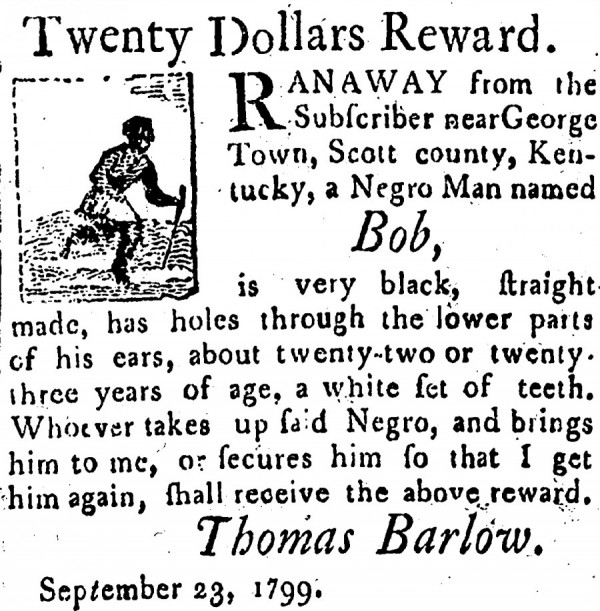Cincinnati has earned its reputation as an important way station on the Underground Railroad, but we must remember that slave traffic flowed both ways at the Ohio River. Some of the slaves who passed through Cincinnati were not headed north to freedom, but south to bondage.

Extracted from microfilm by Greg Hand
It is true that Ohio was a free state, a state that prohibited slavery. But there are other forms of bondage. In his essay “Slavery and Freedom In The Early Republic” [Ohio Valley History, Spring 2006], Emil Pocock explains that “freedom” had shades of meaning in Nineteenth-Century America:
“Freedom and slavery in the early American republic were not absolute conditions separated by an immutable line in law or practice, but rather were the extremes along a continuum in the status of persons. Legal restraints on their respective liberties, civil rights, and political privileges largely defined the status of free men, women and children, apprentices, indentured servants, slaves, and other classes of persons. Ambiguities in territorial, federal, and state statutes, inconsistent interpretation of the laws and their enforcement, and a wide variation in local practices blurred rather than clarified these status boundaries.”

Extracted from microfilm by Greg Hand
Ohio prohibited slavery, but only in the sense that no one could buy or sell slaves within the state. Not until 1841 did Ohio enact a law so that any slave brought into the state automatically became free. Before then, Southern slave owners regularly visited Ohio and especially Cincinnati accompanied by slaves. Ohio laws allowed slave owners to bring their slaves into the state for unspecified periods of time before those slaves were considered free. Slaves who gained freedom, as Pocock points out, discovered that there was “freedom” and there was “freedom”:
“White settlers held black adults and children, some of whom were former slaves, to involuntary labor north of the Ohio River as indentured servants. Other slaves brought across the river may have been coerced to remain under the control of their owners under threat of being sent back to a slave state. Some slaves may have voluntarily acquiesced in this arrangement by concluding that a life of labor in a free state was preferable to life as a slave south of the river, even though there may have been little actual difference in their condition. Nominally, free blacks may have found some benefit in living under the protection of a white family, even if this arrangement diminished their actual freedom.”
The Northwest Ordinance of 1787 prohibited slavery in the territory. However, when Ohio, Indiana and Illinois were carved out of the Northwest Territory, each state debated whether to legalize slavery. The political battles were fierce and, although pro-slavery efforts failed, the new states quickly approved laws that imposed punitive restrictions on the freedom of African Americans. Ohio did not fully repeal these so-called “Black Laws” until 1887.
Whatever the individual states decided, the federal Fugitive Slave Act of 1793 made it legally obvious that no slave became free simply by entering a free state. From almost the time Ohio was settled, the state and Cincinnati in particular became the hunting ground for slave catchers who earned rich rewards for returning runaway slaves to their Southern masters.

Extracted from microfilm by Greg Hand
Cincinnati newspapers were filled with advertisements offering rewards for fugitive slaves. The most famous of these ads, which appeared in Cincinnati’s Western Spy newspaper for 19 June 1802, was placed by future U.S. President Andrew Jackson. At that time, Jackson was a colonel in the Tennessee militia and had not yet acquired his great estate known as Hermitage, but he owned many slaves on his plantation near the Cumberland River. He offered $50 for the return of a slave named George.
Jackson was not alone in advertising rewards. One Thomas Barlow of Georgetown, Kentucky in 1799 offered a $20 reward for the return of a runaway named Bob. In the same issue of the Cincinnati newspaper, a Mr. Wells of Fort Wayne, Indiana, announced that he had captured two fugitive slaves, Bill and John, and was holding them, presumably for the reward they would bring.
In 1805, John McQuady and Samuel Berry of Woodford County, Kentucky, ran an advertisement offering $100 for the recovery of eight runaway slaves ranging from 16 to 45 years of age. Among them was a man named John, about 25 years of age, whose “back has been well marked by the whip.”
The same issue features an advertisement about a “Runaway Negro.” This runaway was specifically not a slave, but indentured under contract to one William Ross of Limestone (now Maysville) Kentucky. The indenture was signed in Greensburgh, Pennsylvania. At the time, Pennsylvania was still a slave state. A law passed in 1780 provided for gradual abolition of slavery, prohibiting importation or sale of slaves and providing that any children born to slave mothers would become free after a period of indentured servitude. By 1805, there were still more than 1,000 slaves in Pennsylvania.
Throughout the decades there are many examples of slaves sent back south after being captured in Cincinnati. Levi Coffin tells the story of a slave named Jackson, once owned by William King who served as Vice President under Franklin Pierce. Jackson ran away to Cincinnati, but was caught here and sent to Alabama. Toni Morrison’s wrenching novel, Beloved, tells the story, based on historical fact, of Margaret Garner, who escaped with her husband and children across the Ohio River but was captured in Cincinnati, where she killed her daughter rather than allow her to be returned to slavery. Henry Walton Bibb escaped slavery in Kentucky and made it to Detroit and was returning to rescue his family when he was betrayed and recaptured in Cincinnati.
The Underground Railroad carried many people north to freedom, but far too many were railroaded back south.
This article was reposted with permission from Greg Hand, editor of Cincinnati Curiosities




Facebook Comments